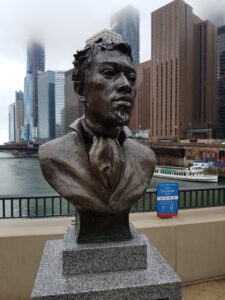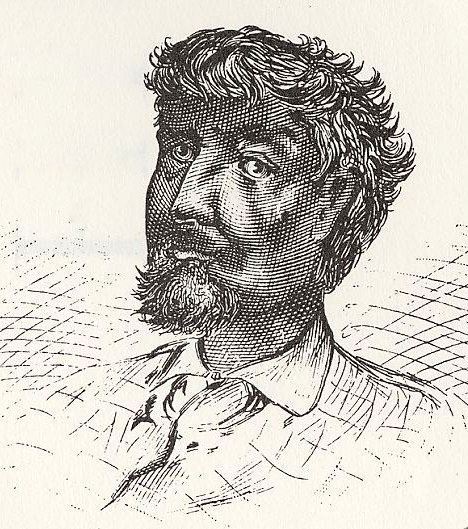Jean-Baptiste-Point DuSable, a frontier trader, trapper and farmer is generally regarded as the first resident of what is now Chicago, Illinois. There is very little definite information on DuSable’s past. It is believed by some historians that he was born free around 1745 in St. Marc, Saint-Dominique (Haiti). His mother was an African slave, his father a French mariner. DuSable traveled with his father to France, where he received some education. It was through this education and the work that he performed for his father on his ships, that he learned languages including French, Spanish, English, and many Indian dialects.
DuSable arrived in New Orleans, Louisiana in 1765 whereupon he learned the colony had become a Spanish possession. Having lost his identification papers and been injured on the voyage to New Orleans, DuSable was almost enslaved. French Jesuit priests protected him until he was healthy enough to travel. DuSable migrated north, up the Mississippi river, later settling in an area near present-day Peoria, Illinois. He also lived in what is now Michigan and Indiana as well during the 1770s. In 1779 DuSable was arrested at what is now Michigan City, Indiana by British troops who considered him a spy and was imprisoned briefly at Fort Michilimackinac before being released to manage a tract of woodlands claimed by British Lt. Patrick Sinclair on the St. Clair River in Eastern Michigan. Sometime in the late 1770s DuSable married a Pottawatomie Indian woman, Kitihawa who was also called Catherine in a traditional Pottawatomie ceremony. The couple had a daughter, Susanne, and a son, Jean. They married again in a Catholic ceremony in Cahokia on the Mississippi River on October 27, 1788.

Sometime in 1779 the DuSables settled on the shore of Lake Michigan in a marshy area the Indians called Eschikagu, “the place of bad smells.” He built a home on the north bank of the Chicago River, claimed about 800 acres of land and established a thriving trading post which included a mill, smokehouse, workshop, barn and other smaller buildings. The post became a major supply station for other traders in the Great Lakes region. The DuSable cabin was filled with fine furniture and paintings indicating that the family had become prosperous for the time and region and DuSable was described as a large man who was also a wealthy trader. In 1796 their grand-daughter became the first child born in what would become Chicago.
On May 7, 1800, DuSable sold his trading post for $1,200 to Chicago resident John Kinzie and moved to St. Charles, Missouri which at the time was part of French Louisiana. He was commissioned by the French governor in Missouri to operate a ferry across the Missouri River. DuSable, however never prospered as he did in what would become Chicago. In 1818 he died almost penniless and was buried in a Catholic cemetery in St. Charles. Later Chicago would honor its first citizen. A high school, museum, harbor, park and bridge in Chicago have been named or renamed after him and the place where he settled at the mouth of the Chicago River is recognized as a National Historical Landmark.

